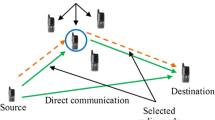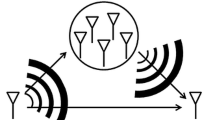Abstract
In an effective Wireless Network (WN), low latency and reliability are essential to provide adequate infrastructure for better communication. Cooperative Communication is one efficient way to achieve these wireless network goals. In this research, the machine learning-based Decode and Forward (DF) coding was developed in conjunction with the network coding algorithm to improve cooperative communication and system functionality that select relays which will not cause interference in a wireless network. Here, the Interference-Thwarting Relay Selection (ITRS) technique is intended to aid reliable communication while reducing self-interference. It is possible to monitor and measure suitable relays in the communication process with the help of a machine learning system. Thus, the proposed Interference-Thwarting Relay Selection technique is implemented with the parameters like Bit Error Rate (BER) as 10−6, Signal to Noise Ratio (SNR) as 36 dB, Symbol Error Rate (SER) as 10−8 and throughput with the power allocation factors. The simulated Machine Learning-Optimized Relay Selection Method (ML-ORSM) results achieve the improved optimal power allocation with symbol error rate.





Similar content being viewed by others
Data availability statement
Data sharing applies to this article on request.
Abbreviations
- ANN:
-
Artificial neural network
- AF:
-
Amplify-and-forward
- BER:
-
Bit error rate
- BRSS:
-
Best relay selection scheme
- BRS-DF:
-
Best relay selection based decode & forward
- CSI:
-
Channel state information
- CRS-No-NC:
-
Conventional relay selection with no network coding
- DF:
-
Decode-and-forward
- DRS-NC:
-
Dual relay selection with network coding
- DT:
-
Direct transmission
- FD-AF-RN:
-
Full duplex amplify and forward relay networks
- ITRS:
-
Interference thwarting relay selection
- SNR:
-
Signal to noise ratio
- SER:
-
Symbol error rate
- MCS:
-
Modulation & coding scheme
- ML-ORSM:
-
Machine learning-optimal relay selection method
- ORSM:
-
Optimal relay selection method
- RP-DF:
-
Relay participate decode and forward
- SRS-NC:
-
Single relay selection with network coding
- NC-No-RS:
-
Network coding with no relay selection
References
Gubbi, J., Buyya, R., Marusic, S., & Palaniswami, M. (2013). Internet of Things (IoT): A vision, architectural elements, and future directions. Future Generation Computer Systems, 29(7), 1645–1660.
Valle, O. T., et al. (2016). NetCoDer: A retransmission mechanism for WSNs based on cooperative relays and network coding. Sensors, 16(6), 799.
Gungor, V. C., & Hancke, G. P. (2009). Industrial wireless sensor networks: Challenges, design principles, and technical approaches. IEEE Transactions on Industrial Electronics, 56(10), 4258–4265.
Li, X., et al. (2018). A three-factor anonymous authentication scheme for wireless sensor networks in internet of things environments. Journal of Network and Computer Applications, 103(1), 194–204.
Lazarescu, M. T. (2013). Design of a WSN platform for long-term environmental monitoring for IoT applications. IEEE Journal on Emerging and Selected Topics in Circuits and Systems, 3(1), 45–54.
Han, G., et al. (2018). A source location protection protocol based on dynamic routing in WSNs for the Social Internet of things. Future Generation Computer Systems, 82, 689–697.
Wang, C. L., & Syue, S. J. (2009). An efficient relay selection protocol for CWSN. In IEEE wireless communications and networking conference (pp. 1–5).
Alkhayyat, A., Gazi, O., & Sadkhan, S. B. (2015). The role of delay and connectivity in throughput reduction of cooperative decentralized wireless networks. Mathematical Problems in Engineering, 2015, 1–10.
Khan, R. A. M., & Karl, H. (2013). MAC protocols for cooperative diversity in wireless LANs and wireless sensor networks. IEEE Communications Surveys & Tutorials, 16(1), 46–63.
Jamal, T., & Mendes, P. (2010). Relay selection approaches for wireless cooperative networks. In IEEE 6th international conference on wireless and mobile computing, networking and communications (pp. 661–668).
Kara, F., & Kaya, H. (2020). Improved user fairness in decode-forward relaying non-orthogonal multiple access schemes with imperfect SIC and CSI. IEEE Access, 8, 97540–97556.
Ferdouse, L., & Anpalagan, A. (2015). Relay selection based on Bayesian decision theory in cooperative wireless networks selection theory. Canadian Journal of Electrical and Computer Engineering., 38(2), 116–124.
Nguyen, T. T., Lee, J. H., Nguyen, M. T., & Kim, Y. H. (2019). Machine learning-based relay selection for secure transmission in multi-hop DF relay networks. Electronics, 8, 949.
Saber, M., El Rharras, A., Saadane, R., Aroussi, H. K., & Wahbi, M. (2019). Artificial neural networks, support vector machine and energy detection for spectrum sensing based on real signals. International Journal of Communication Networks and Information Security, 11(1), 52–60.
Gouissem, A., Samara, L., Hamila, R., Al-Dhahir, N., Ben-Brahim, L., & Gastli, A. (2019). Machine-learning based relay selection in AF cooperative networks. In IEEE wireless communications and network in conference (pp. 1–7).
Al-Qahtani, F. S., Zhong, C., & Alnuweiri, H. M. (2015). Opportunistic relay selection for secrecy enhancement in cooperative networks. IEEE Transactions on Communications, 63(5), 1756–1770.
Amiri, R., Mehrpouyan, H., Fridman, L., Mallik, R. K., Nallanathan, A., & Matolak, D. (2018). A Machine learning approach for power allocation in HetNets considering QoS. In 2018 IEEE international conference on communications (ICC). IEEE.
Bhatnagar, M. R. (2012). Performance analysis of a path selection scheme in multi-hop decode-and-forward protocol. IEEE Communications Letters, 16(12), 1980–1983.
Young, J. (2016). Machine learning-based antenna selection in wireless communications. IEEE Communications Letters, 20(11), 2241–2244.
Paek, M. J., Na, Y. J., Lee, W. S., Ro, J. H., & Song, H. K. (2020). A novel relay selection scheme based on Q-learning in multi-hop wireless networks. Electronics. Applied Sciences, 10(15), 5252.
Xie, X., Peng, S., & Yang, X. (2020). Deep learning-based signal-to-noise ratio estimation using constellation diagrams. Mobile Information Systems, 2020, 1–9.
Nhon, T., & Kim, D.-S. (2014). Relay selection scheme for hierarchical wireless sensor networks. International Journal of Control and Automation, 7(3), 147–160.
Boutaba, R., Salahuddin, M. A., Limam, N., Ayoubi, S., Shahriar, N., Estrada-Solano, F., & Caicedo, O. M. (2018). A comprehensive survey on machine learning for networking: Evolution, applications and research opportunities. Journal of Internet Services and Applications, 9(16), 1–99.
Author information
Authors and Affiliations
Corresponding author
Ethics declarations
Conflict of interest
The authors declare that they have no conflicts of interest.
Human and animal rights
This article does not contain any studies involving human participants performed by any of the authors.
Additional information
Publisher's Note
Springer Nature remains neutral with regard to jurisdictional claims in published maps and institutional affiliations.
Rights and permissions
Springer Nature or its licensor (e.g. a society or other partner) holds exclusive rights to this article under a publishing agreement with the author(s) or other rightsholder(s); author self-archiving of the accepted manuscript version of this article is solely governed by the terms of such publishing agreement and applicable law.
About this article
Cite this article
Rathika, M., Sivakumar, P. Machine learning-optimized relay selection method for mitigating interference in next generation communication networks. Wireless Netw 29, 1969–1981 (2023). https://doi.org/10.1007/s11276-023-03258-z
Accepted:
Published:
Issue Date:
DOI: https://doi.org/10.1007/s11276-023-03258-z




